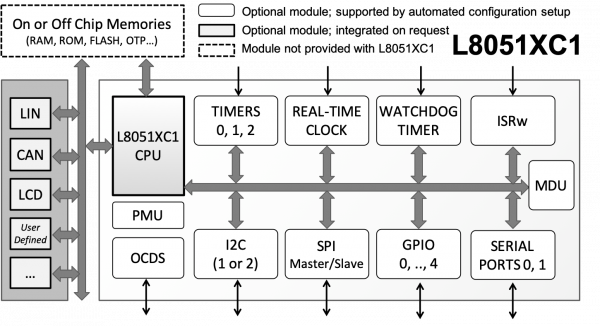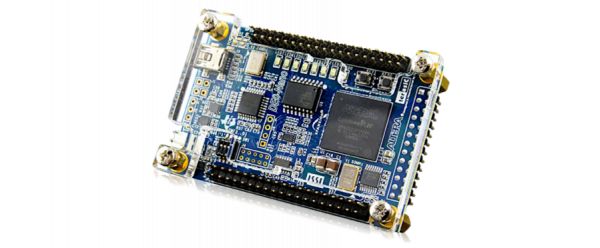Silicon IP Cores
L8051XC1
Legacy-Configurable 8051-Compatible Microcontroller IP
The L8051XC1 core implements an MCS®51-compatible microcontroller that is specially designed to match the timing and peripherals of legacy 8051 MCU-based systems.
The core can be configured to execute an instruction every 12, 6, or 4 clock cycles. Architectural extensions are user-selectable, including multiple data-pointers, a multiply-division unit, and a power management unit. Furthermore, the 8051 CPU can be coupled with a wide range of peripherals matching the behavior and timing of peripherals found in legacy architectures from Intel, Philips/NXP, Siemens/Infineon, Maxim/Dallas, Texas Instruments and others. Several pre-configured versions are offered; custom variations are also available.
The L8051XC1 runs legacy code, but new software development is facilitated through CAST’s on-chip debugging option, and debug pods that cooperate with IAR Embedded Workbench & Keil uVision™ IDEs
This product builds on CAST’s experience with hundreds of 8051 IP customers going back to 1997. Designed for easy reuse in ASICs or FPGAs, the core is strictly synchronous, with positive-edge clocking (except in the optional debug & SPI modules), synchronous reset, and no internal tristates. Representative 65nm ASIC results show the core to be conservative in its use of space, requiring just 7,900 to 20,000 gates.
Three standard core versions are available, offering a range of capabilities and prices.
- L8051XC1-A includes options that match the original Intel 8051 peripheral set: 64KB memory interface, two timers, one serial port, four parallel I/O Ports, two-level interrupt controller, and two DPTR registers. These options are user-configurable (i.e., may be deleted prior to synthesis).
- L8051XC1-B includes options that match the Infineon 80515/80517 peripheral set: 64KB memory interface, three timers, two serial ports, four parallel I/O ports, watchdog timer, multiplication-division unit, and two DPTR registers. These options are user-configurable (i.e., may be deleted prior to synthesis).
- L8051XC1-C has custom/user-defined architectural and peripheral options. This version may integrate user-defined peripherals that are not supported by the automatic configuration tool. Please consult with your CAST sales contact to discuss your specific requirements and get lead time information.
ASIC (RTL) and FPGA (netlist) deliverables are available; FPGA packages are not user-configurable.
The L8051XC1 MCU core is especially effective for extending the lifetime of existing systems where an originally used discrete 8051 chip is difficult to replace, or the designer wishes to consolidate a multi-board system into a single FPGA or ASIC
The core has been verified through extensive simulation and rigorous code coverage measurements. All subcomponents were functionally verified with an HDL testbench using their individual test suites. The CPU and ALU have been verified against a proprietary hardware modeler and behavioral models. The peripherals have also been verified in their own testbenches, based on either hardware or behavioral models. An extensive constrained random verification was performed to verify the CPU, DMA and OCDS.
Support
The core as delivered is warranted against defects for ninety days from purchase. Thirty days of phone and email technical support are included, starting with the first interaction. Additional maintenance and support options are available; contact CAST Sales.
Deliverables
The core is available in ASIC (synthesizable HDL) or FPGA (netlist) forms, and includes everything required for successful implementation. ASIC versions include:
- HDL RTL source code
- Easy-to-use configuration tool (with configurable versions)
- An example chip implementation, which uses the core in a sample system
- Sophisticated self-checking HDL Testbench including everything needed to test the core (Verilog versions use Verilog 2001)
- Simulation script, vectors, and expected results
- Synthesis script
- Comprehensive user documentation, including detailed specifications and a system integration guide
A reference design board is available; contact CAST Sales for information.
L8051XC1 designs have been evaluated in a variety of technologies. The following are sample ASIC pre-layout results reported from synthesis with a silicon vendor design kit under typical conditions, with all core I/Os assumed to be routed on-chip. The target technology is TSMC 40nm. Please contact CAST to get characterization data for your target configuration and technology.
| Configuration | Technology | Area (EQ. Gates) | Freq (MHz) |
|---|---|---|---|
| L8051XC1 (CPU - Only) | TSMC 65nm | 7,900 | 100 |
| L8051XC1-A | TSMC 65nm | 11,500 | 100 |
| L8051XC1-B | TSMC 65nm | 19,000 | 100 |
| L8051XC1 (CPU - Only) | TSMC 16nm | 7,000 | 300 |
| L8051XC1-A | TSMC 16nm | 10,250 | 300 |
| L8051XC1-B | TSMC 16nm | 17,000 | 300 |
A 1-channel DMA requires an additional 3.5K gates. Each additional channel requires 2K gates.
OCDS requires an additional 4K gates for 2 hardware breakpoints.
The provided figures do not represent the higher speed or smaller area for the core and area figures do not include any memories.
Engineered by Silesia Devices.
Features List
- Fully compatible with the MCS® 51 instruction set
- Configurable CPU architecture: 12, 6, or 4 clock cycles per machine cycle
- Extensive set of optional features and peripherals
- JTAG-based On-Chip Debug Support (OCDS)
- Integration with IAR Embedded Workbench & Keil uVision™ IDEs
Options and Peripherals
A wide range of architectural options and peripherals is available for integration with the L8051XC1, and more peripherals can be developed on demand. The following is partial list of the off-the-shelf available peripherals:
- External Memory Interface:
- One, two or eight Data Pointers for fast data block transfer
- Additional Arithmetic Unit supports data pointers, auto-increment/-decrement, and auto-switch
- Supports external DMA controller through HOLD function
- Program memory write mode
- Direct Memory Access (DMA) Controller
- Multiplication-Division Unit
- 37 to 119 external Special Function Registers
- Interrupt Controller with two or four priority levels, and six or eighteen interrupt sources
- Up to five Parallel I/O Ports
- Serial 0 full-duplex serial interface (80C51-like), equipped with an additional baud rate generator
- Serial 1 (asynchronous-only version of Serial 0) interface
SPI Master/Slave interface - One or two I2C™ Master/Slave interfaces
- Timers 0, 1 and Timer 2 with Compare/Capture (80C515-like)
- 15-bit programmable Watchdog Timer
- Real Time Clock
- Power Management Unit with power-down modes (IDLE/STOP)
Resources
Development Tools & Options
Code and debug this 8051 with these popular IDEs:
IAR Systems Embedded Workbench for 8051
These tools work with an optional, native on-chip debug block and inexpensive external adapter (pod) with a JTAG four-wire or SWAT Single-Wire PC interface.
Evaluation: Try it for Yourself
Easily evaluate this 8051's features and performance in your own environment with the
Talos Series Evaluation Kit for 8051s.
Articles
Understanding Interrupt Latency in Modern 8051s
by Nikos Zervas at ChipEstimate.com





